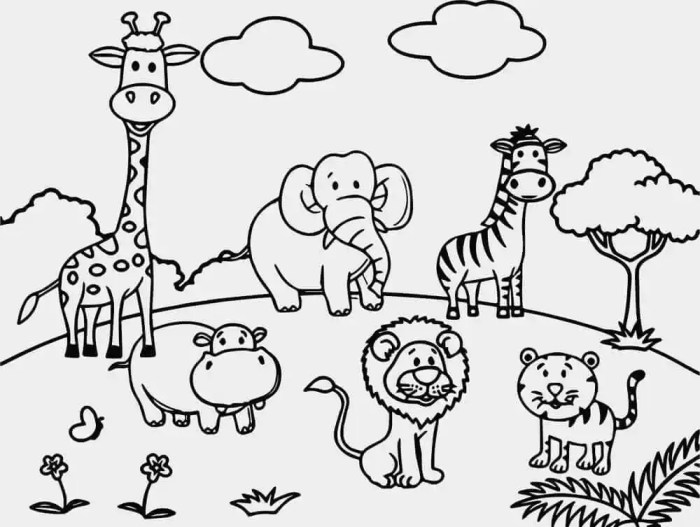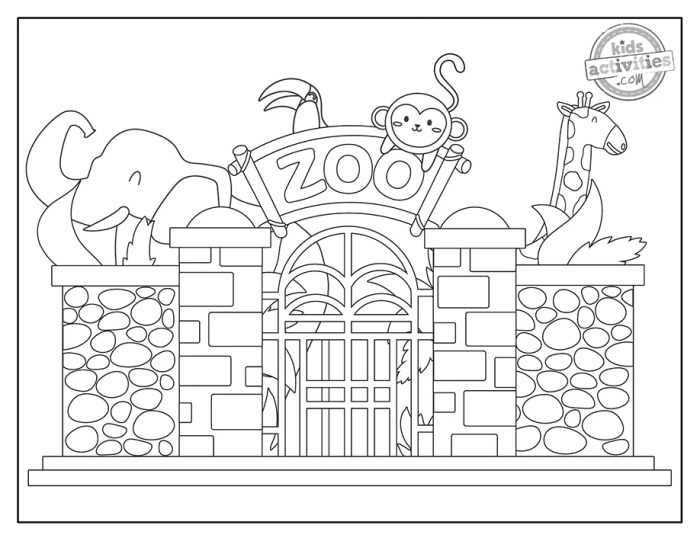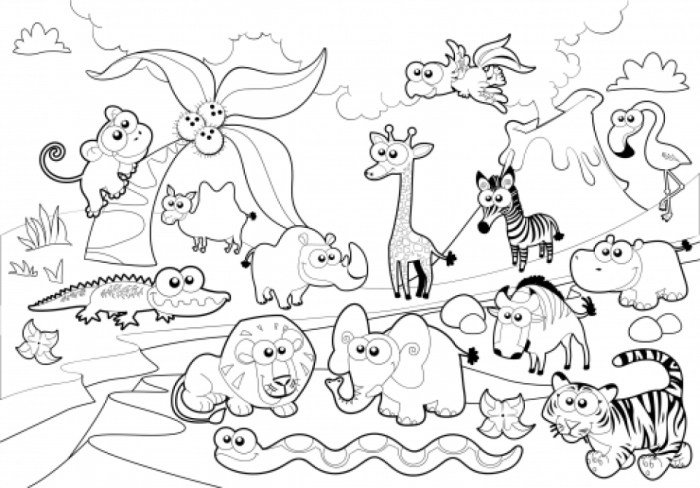Content Analysis of Existing Free Zoo Animal Coloring Sheets

Free zoo animal coloring sheets offer a valuable resource for children’s entertainment and educational development. Analyzing their content reveals trends in design, complexity, and artistic choices that influence their appeal and effectiveness. This analysis focuses on categorizing these sheets based on animal representation, complexity of design, color palette usage, and overall aesthetic impact.
Categorization of Coloring Sheets by Animal Species
A wide variety of zoo animals are depicted in freely available coloring sheets. Common categories include mammals (lions, tigers, bears, elephants, monkeys, giraffes), birds (owls, parrots, flamingos, penguins), reptiles (snakes, crocodiles, lizards), and aquatic animals (sharks, dolphins, whales, sea turtles). The prevalence of certain animals likely reflects their popularity and familiarity to children. Some sheets might feature a single animal, while others present multiple species within a single scene, creating a more complex and engaging image.
Complexity Level of Designs
The complexity of coloring sheet designs varies significantly. Simple designs, categorized as “easy,” often feature bold Artikels, large areas of color, and minimal detail. These are suitable for younger children with limited fine motor skills. “Medium” complexity designs incorporate more intricate details, such as fur texture, scales, or feathers, requiring more precision and control. “Hard” designs, intended for older children or adults, feature highly detailed illustrations with many small sections requiring careful coloring and shading.
The complexity level directly influences the time and skill required to complete the coloring sheet.
Color Palette Usage and Appeal
The color palette used in a coloring sheet significantly impacts its overall appeal. Vibrant and saturated colors are generally more engaging for children, while more muted or pastel palettes can create a calmer, more serene atmosphere. The choice of colors can also enhance the realism or stylistic interpretation of the animal. For instance, using realistic fur tones for a lion versus using vibrant, almost cartoonish colors will evoke different responses.
The effective use of color can help bring the animal to life and enhance the overall coloring experience.
Examples of Zoo Animal Coloring Sheets
The following table provides examples of coloring sheets, categorized by animal, style, complexity, and source (if available). Note that source links may not always be readily available for free, publicly accessible resources.
| Animal | Style | Complexity | Source Link |
|---|---|---|---|
| Lion | Realistic | Medium | [Example Source Link – Replace with actual link if available] |
| Giraffe | Cartoonish | Easy | [Example Source Link – Replace with actual link if available] |
| Penguin | Simple | Easy | [Example Source Link – Replace with actual link if available] |
| Elephant | Detailed | Hard | [Example Source Link – Replace with actual link if available] |
Design and Creation of New Coloring Sheet Ideas

The creation of engaging and educational zoo animal coloring sheets requires careful consideration of design elements and the target audience. Successful designs will balance visual appeal with educational value, ensuring a fun and enriching experience for children. The following examples illustrate different approaches to achieving this balance.
Lion Cub Playing with a Ball, Free zoo animal coloring sheets
This design focuses on a single, endearing subject: a playful lion cub interacting with a brightly colored ball. The image would depict the cub in a dynamic pose, perhaps mid-pounce or playfully batting the ball. The style should be simple and child-friendly, with bold Artikels and clear spaces for coloring. The background could be a simple, uncluttered scene – perhaps a patch of grass or a sandy area – to avoid distracting from the central image.
Color choices should be vibrant and appealing to young children, employing a range of warm and earthy tones. The overall composition should be balanced and easy to color within the lines, minimizing frustration for young artists.
Diverse Range of Zoo Animals in Their Habitats
This coloring sheet will showcase a variety of animals in their natural or simulated zoo environments. Animals could include a giraffe in a savanna setting, a polar bear on an ice floe, a monkey swinging through a jungle, and a penguin in a snowy habitat. Each animal would be clearly defined and easily identifiable, allowing children to recognize and learn about different species.
The habitats would be simplified but recognizable, incorporating key elements such as trees, rocks, and water. The style would maintain a consistent level of detail across all animals, ensuring a visually balanced and engaging composition. This design promotes awareness of biodiversity and different animal habitats.
Animal Body Parts Labeling
This educational coloring sheet features a single animal, perhaps an elephant or a giraffe, with its major body parts clearly labeled. Simple, clear labels like “trunk,” “ear,” “leg,” and “tail” would be placed near the corresponding body parts. The style would be straightforward and uncluttered, focusing on accurate anatomical representation while maintaining a child-friendly aesthetic. The coloring area would be ample, allowing for creative expression while still clearly showcasing the labeled body parts.
While free zoo animal coloring sheets offer a classic, accessible creative outlet, the digital realm provides a wider range of options. For instance, the vibrant styles available in the anime coloring book app offer a compelling alternative for those seeking more stylized designs. However, the simplicity and tactile experience of traditional coloring sheets, especially for younger children, shouldn’t be overlooked.
This design combines coloring fun with basic anatomical learning, making it a valuable educational tool.
Coloring Sheet Design Process
The design process for a coloring sheet typically involves several stages. First, a concept is developed, selecting the subject and the overall style. This is followed by sketching, where the basic composition and animal poses are Artikeld. Next, the sketch is refined, ensuring accurate proportions and details. Then, the line art is created, producing clean, bold Artikels suitable for coloring.
Finally, the artwork is prepared for printing, considering factors like page size, color palette, and file format. Throughout this process, careful consideration is given to the target age group, ensuring the design is age-appropriate in terms of complexity and detail. For example, younger children might benefit from simpler designs with fewer details, while older children could handle more complex illustrations.
Target Audience and User Experience: Free Zoo Animal Coloring Sheets
Free zoo animal coloring sheets cater to a broad audience, primarily children, but their design and accessibility should consider the diverse needs and abilities within that group. Effective design fosters engagement and ensures inclusivity for all young users.The primary age group for these coloring sheets spans preschoolers (ages 3-5) to early elementary school children (ages 6-8). However, older children and even adults might find them enjoyable as a relaxing creative outlet.
Therefore, design choices should account for varying levels of fine motor skills and attention spans.
Primary Age Group and Design Considerations
The design of coloring sheets for preschoolers should prioritize large, simple shapes and bold Artikels. Thick lines are crucial for ease of coloring within the boundaries, accommodating less-developed fine motor skills. Images should depict familiar and appealing zoo animals, such as elephants, lions, or monkeys, with easily recognizable features. For older children (ages 6-8), more detailed illustrations with smaller shapes and intricate patterns can be incorporated, offering a greater challenge and opportunity for creative expression.
A variety of designs, catering to different skill levels, ensures that all children within the target age range find suitable options.
Characteristics of a User-Friendly Coloring Sheet Design
A user-friendly coloring sheet balances visual appeal with practicality. Clear, bold Artikels are essential to prevent frustration. Sufficient spacing between images prevents accidental coloring over adjacent areas. The paper’s quality should be considered; thicker paper prevents bleed-through, especially when using markers or watercolors. The overall design should be visually appealing, incorporating vibrant colors and engaging animal illustrations that spark the child’s imagination.
For instance, a playful lion with a vibrant mane or a colorful parrot perched on a branch would be more engaging than a simple, unadorned Artikel.
Accessibility Considerations for Children with Different Abilities
Accessibility is paramount. For children with visual impairments, high-contrast coloring sheets with bold Artikels and simplified images are crucial. Large print labels identifying the animals are beneficial. For children with motor skill challenges, using thicker lines and larger areas to color can reduce frustration. Consider incorporating alternative coloring methods, such as using paint or large crayons, to accommodate different needs.
For example, a child with limited hand control might benefit from using a large paintbrush instead of a thin-tipped crayon. Providing a variety of formats, including digital versions for screen readers, further enhances accessibility.
Effective Visual Elements that Enhance User Engagement
Engaging visual elements significantly impact a child’s enjoyment. Vibrant colors are essential to capture attention. The inclusion of playful details, such as expressive animal faces or dynamic poses, adds interest. Adding simple background elements, such as trees, rocks, or water, can create a more immersive experience. For example, a zebra in a savanna setting would be more engaging than an isolated zebra on a plain white background.
Incorporating interactive elements, such as simple puzzles or mazes integrated into the design, can further enhance engagement, especially for older children. This could involve creating a maze for a small animal to navigate to its food source.
Illustrative Examples and Descriptions

These examples detail coloring sheet designs, focusing on visual elements and color suggestions to inspire creativity and engagement. Each description aims to provide a vivid image for the user, allowing them to envision the completed coloring page.
Playful Monkey Swinging from a Tree
This coloring sheet depicts a playful monkey, perhaps a capuchin or squirrel monkey, swinging exuberantly from a thick, leafy branch. The monkey is mid-swing, its limbs outstretched, a mischievous grin on its face. The tree itself is lush and detailed, with various leaves and vines. Color suggestions include vibrant greens for the leaves, browns and grays for the tree trunk, and bright, playful colors for the monkey – perhaps a sunny yellow, bright orange, or even a mix of blues and greens for a more fantastical look.
The background can be a simple, light blue sky or a more complex scene of a jungle canopy.
Majestic Elephant Family in a Savanna Landscape
This coloring sheet features a majestic African elephant family – a mother, father, and a calf – amidst a sprawling savanna landscape. The mother elephant is large and imposing, her skin detailed with wrinkles and textures. The father stands slightly behind, providing a sense of protection. The calf playfully nuzzles its mother’s leg. The savanna is rendered with tall grasses, acacia trees, and perhaps a distant watering hole.
Color suggestions include various shades of gray for the elephants, with subtle hints of brown and pink for the skin’s texture. The grasses can be rendered in yellows, greens, and browns, while the acacia trees are dark browns and greens. The sky should be a clear, bright blue, perhaps with a few fluffy white clouds.
Polar Bear Swimming in Icy Water
This coloring sheet showcases a polar bear swimming gracefully in icy blue water. The bear’s fur is thick and textured, with individual hairs suggested by short, slightly curved lines. The ice is depicted with cracks and crevices, showing varying shades of blue, white, and even hints of gray. The water itself should be a deep, translucent blue, reflecting the light from above.
Color suggestions include various shades of white and cream for the bear’s fur, with subtle hints of light brown or gray for shading. The ice should be rendered in varying shades of blue and white, with darker blues in the crevices and lighter shades on the surface. The texture of the fur can be emphasized with short, slightly curved lines, while the ice can be textured with short, jagged lines to represent cracks and uneven surfaces.
Huddled Penguins for Warmth
This coloring sheet depicts a group of penguins, huddled closely together for warmth on a snowy, icy landscape. The penguins are shown in a tight cluster, their bodies touching, creating a sense of community and protection against the harsh elements. The background includes a stark, snowy landscape with a few jagged ice formations. Color suggestions include various shades of black and white for the penguins, with subtle hints of gray for shading.
The snow can be rendered in various shades of white, with subtle hints of blue or gray to suggest shadows and depth. The overall mood should be one of warmth and companionship, despite the cold setting. The penguins’ bodies should be tightly clustered, conveying the idea of mutual warmth and protection.
